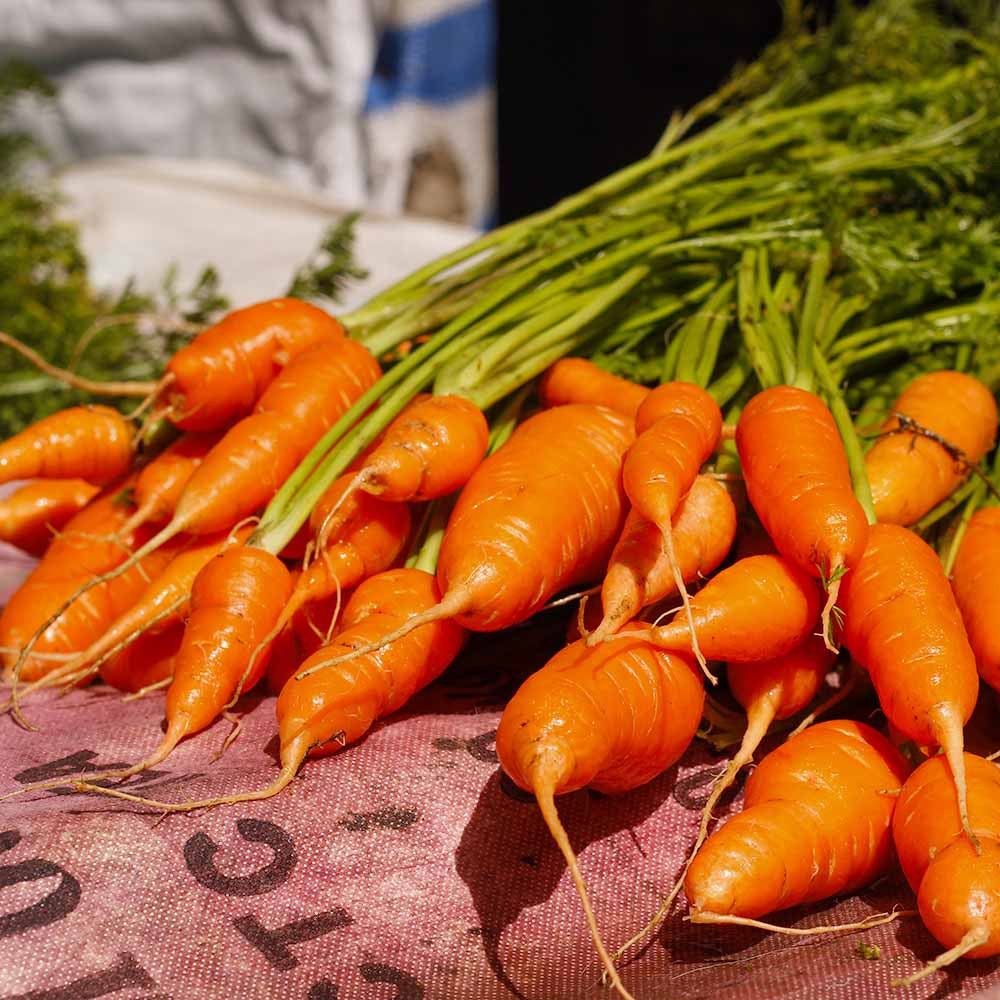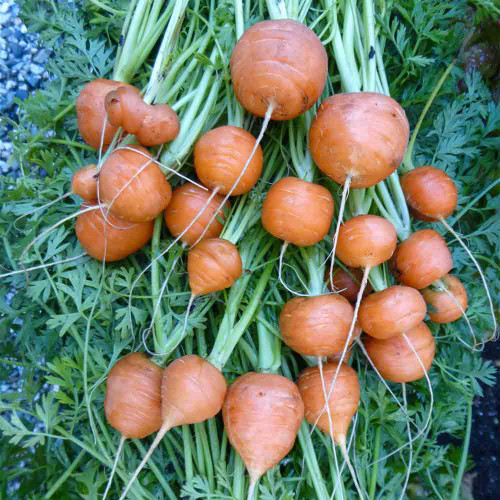Bambino Carrot Seeds - (Daucus carota var. sativus)
- SKU:
- V1331
- Seed Count:
- Approx 500 seeds per pack
- Days to Maturity:
- 60 days
- Shape:
- Stubby
- Days to Germination:
- 6-21 days @ 50-75F
- Plant Spacing:
- 1-2"
- Light Preference:
- Full sun
- Soil Requirements:
- Light, sandy or humus, well drained soil
- Status:
- Heirloom, Non-Hybrid, Non-GMO seeds
Description
Bambino Carrot - The Little Carrot That Could
Meet a delightful miniature carrot that's as rewarding to grow as it is delicious to eat. Whether you're a seasoned gardener or just starting out, the Bambino carrot is perfect with its quick growth, compact size, and exceptional flavor. Offering a concentrated sweetness and delightfully crisp texture, its compact size makes it ideal for container gardening, allowing even those with limited space—from balcony gardens to windowsill pots—to enjoy the pleasures of homegrown carrots.
Details
The Bambino boasts slender, cylindrical roots that reach about 4 inches in length and have a blunt tip. These vibrant orange roots possess smooth skin and a very small core. Maturing quickly, typically in 55-60 days, their color develops early, making it easy to harvest them at the perfect moment. Its foliage, aptly described as "dwarf tops," reflects its relatively small size compared to other carrot varieties. And here's a delightful bonus: the Bambino carrot offers a more concentrated sweetness and flavor than larger carrots, which can lose their vibrancy when overgrown.
History
The history of the carrot is a long and fascinating tale, spanning centuries and continents. While we relish today's sweet, orange carrots, their ancestors were quite different. Evidence suggests that carrots were first cultivated for their aromatic leaves and seeds, not their roots, as far back as 2000-3000 BC in regions like Switzerland and southern Germany. Some close relatives of the carrot, such as parsley, coriander (cilantro), fennel, anise, dill, and cumin, are still grown for their leaves and seeds.
The earliest carrots originated in Central Asia, likely in present-day Afghanistan, around 5,000 years ago. These ancient carrots were primarily purple, with some black or white varieties. Egyptian temple drawings from 2,000 BC even depict these purple carrots.
Carrots gradually spread westward, reaching Europe by the 1st century AD. However, these early European carrots were not the sweet orange variety we know today. They were often purple and were used both for culinary and medicinal purposes. Ancient Greeks, for example, believed carrots to be an aphrodisiac.
The familiar orange carrot didn't appear until the 16th century in Holland. Through careful selective breeding, Dutch farmers enhanced the orange color of carrots, possibly as a tribute to the House of Orange, a symbol of Dutch national pride. This orange variety quickly gained popularity and eventually spread throughout the world.
Today, carrots are one of the most widely cultivated and enjoyed vegetables globally. From their humble beginnings as a medicinal herb with purple roots to the sweet, crunchy orange staple in modern kitchens, the carrot's journey reflects a fascinating interplay of human cultivation, cultural preferences, and natural selection.
Breeders selected for traits like short root length to achieve the "baby carrot" size, early color development for easier harvesting, sweet flavor for fresh eating, and adaptability to container growing, making it suitable for smaller gardens and limited spaces.
Uses
Bambino carrots' sweet flavor and tender texture make them incredibly versatile in the kitchen. Enjoy them fresh from the garden as a healthy snack, or add them to salads for a burst of color and sweetness. Their small size makes them ideal for pickling or roasting whole as a delicious side dish. Try a quick pickle recipe with rice vinegar and mustard seeds for a tangy twist. Thanks to their naturally sweet flavor and soft texture, you can even puree them into baby food.
Companion Planting
Carrots thrive when planted alongside companion plants like lettuce, which shares similar growing requirements and helps keep the soil cool and moist. Radishes are also beneficial, as they break up the soil and act as markers for the slower-growing carrots. To deter pests, consider planting rosemary to repel carrot rust flies and marigolds to protect against nematodes and other soil-borne pests.
Avoid planting dill and fennel near your carrots, as dill can attract aphids, and fennel can inhibit carrot growth.
Planting Tips
After the last frost, sow carrot seeds ¼ inch deep and 3-4 inches apart in rows 12 inches apart. While carrots are slow starters, patience will reward you with abundant seedlings. To ensure proper root development, thin seedlings to 4 inches apart once they have a few true leaves. For a continuous harvest, plant new seeds every 2-3 weeks. Consistent moisture is key for flavorful carrots, so keep the soil evenly moist but not overly damp. Before planting, amend the soil with compost or organic fertilizer. Continue to side-dress with compost every few weeks to maintain healthy growth.
Harvest Tips
For the crispiest, most flavorful carrots, harvest early in the morning before the sun's heat diminishes their moisture. Summer-planted carrots should be harvested promptly upon maturity to prevent splitting, while late-season carrots can stay in the ground longer and often develop increased sweetness with cooler temperatures.
Bambino carrots are typically ready when they reach about 4 inches in length or ¾ to 1 inch in diameter at the shoulder, displaying a vibrant orange color. To harvest, water the soil the day before, then gently loosen the soil around the carrots with a hand trowel. Grasp the greens at the base and pull gently with a slight twisting motion to avoid breaking the roots. For optimal freshness, remove the greens immediately after harvesting.
Learn More
- Grow Delicious Carrots from Seed to Harvest
- Braised and Marinated Carrot Recipes
- Cool Season Vegetables to Love
From the soil to the seed to the food you eat - we'll help you grow your best garden!
3 Reviews
-
Bambino Carrots
We started eating the Bambino carrots I planted this spring. They germinated really good. They grow long and straight. We are enjoying them with sandwiches for lunch. They are also a good size to just snack on. They bring back memories of eating carrots out of my Grandpas garden when I was a child. I definitely will plant them again.
-
Trouble Free
Good germination, nice medium size, colorful orange root. Plants were trouble free.
-
Sweet & crunchy!
We love these carrots and have grown them for two seasons in Montana. Last year we had a few plants that we didn't harvest before the snow - they were still good the following spring!! They have a great crispy crunch and are nice and sweet.















